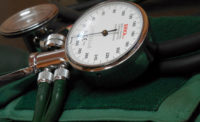High-pressure work: There is a psychic toll to be paid
A 2005 study demonstrated the scope of the health problems of 9-1-1 emergency call centre dispatchers, namely a high rate of musculoskeletal disorders (MSDs) and psychological health problems (PsyHPs) as well as physical and psychosocial risk factors.
Following a first study that described the prevalence of physical and psychosocial risk factors in the municipal public security system emergency call centers (MPSECCs), another research project was launched to clarify how these risks arise in order to develop courses of action aimed at preventing MSDs and PHPs.
This project, developed using a case study methodology, included conducting ergonomic/physiology and work psychodynamics studies in five MPSECCs. These studies led to a better understanding of the presence of the physical and psychosocial risk factors for MSDs and PHPs.
Adjustable sit/stand desks were introduced to prevent the physical risks, thus offering the agents greater flexibility to cope with the various demands imposed by the work and with feelings of musculoskeletal pain or fatigue.
However, the limitations of the worktable design are such that the design does not appear entirely satisfactory in terms of reducing MSD risks. The worktable design should be rethought in light of both the agents’ activities and evolving technologies.
The ergonomic/physiology and work psychodynamics studies enhanced understanding of the presence of psychosocial demands and modes of regulating them. The psychosocial demands, measured through subjective evaluation of the mental workload, were found to be associated with the intensity of musculoskeletal pain, in relation to time spent at work, fatigue, workload, and negative emotion, for the lower back.
For pain in the upper back, neck, or shoulders, this result concurs with an increase in muscle activity and a decrease in rest time and in the EMG of the trapezius muscles.
Significant correlations between the perception measurements and HRV indices were only present in very few agents. The variations in the perceptions measured were slight, and the result appeared highly dependent on interference by many confounding factors present in natural situations. Nonetheless, the heart rate measurement showed a major loss of HRV during the entire workshift for the experienced agents.
This loss of HRV constitutes a physiological response for coping with stress.
The self-confrontation interviews and observation of the cognitive and relational problems in the communicative interactions allowed us to describe the work situations posing a high-level mental workload.
The work psychodynamics analysis completed the picture by providing explicit details on the psychic dimension of the work content. This analysis gave psychic significance to the work situations described in the ergonomic study. It brought to light how, over time, the agents’ occupational experience is built, and the fact that their psychic development is based on the presence of sources of pleasure and defence strategies.
These help the agents consulted to cope with the particular demands of their occupation.
The results of the ergonomic/physiology and work psychodynamics studies shed light on aspects of the work that served as the basis for the development of courses of action by the follow-up committee, taking into account the research project and MPSECC contexts.
These courses of action form part of the development prospects for an occupation that has only been organized relatively recently in Québec. First, efforts were made on the technological level. They involved the purchase of computer equipment to support the agents’ work and of furniture that took into account the demands associated with a job that is performed on a continuous basis, where the agents take turns working at the same workstation.
The results of this study concerning the 84 Study of Interventions to Reduce Musculoskeletal Disorders and Psychological Health Problems in 911 Emergency Call Centres in the Municipal Public Security System- IRSST psychosocial factors show that the efforts in a second phase must be focused on providing cognitive and emotional support at three levels: the agents on the job, the organization of the work, and more generally, the occupation itself.
To be pertinent, this support must be developed starting with the skills acquired by the agents if it is to dispel the uncertainties that generate emotional risks. It also involves cultivating better relationships with first responders, particularly police officers on patrol. For this to happen, the implementation of the courses of action implies having knowledge of the agents’ communication work, which must necessarily involve the various emergency service providers and decision makers in the municipal public service.
Established in Québec since 1980, the Institut de recherché Robert-Sauvé en santé et en sécurité du travail (IRSST) is a scientific research organization.
Looking for a reprint of this article?
From high-res PDFs to custom plaques, order your copy today!





